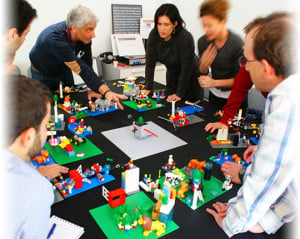FMCG Case Study
WHY DO WE NEED TO CHANGE?
Our client has always been a top brand in his category and this statement can be seen in the company’s strategy and in the way they treat their main competitive advantage: their people.
As the business grows in scale and complexity, old strategies and people approach were no longer satisfying and they were not bringing the expected results, so change was needed.
THE CASE FOR CHANGE
How the new business environment looks like:
- Consumers’ new behaviors and expectations;
- Mergers and acquisitions made by competition;
- The reality inside the Company.
Company’s top management team decided they need to reconsider their position in the market and their approach in order to achieve long term success.
Main focus: to improve the performance of the sales team by ensuring that everybody speaks a common language and build on their capabilities in a systemic way. The goal was to get to the point were we could measure the direct impact that we have in the added value the Company is producing daily.
THE PROCESS OF TRANSFORMATION
When creating the development strategy, two questions were needed to be answered at first:
1. What is working in the Company’s Sales Team and what is not working?
2. After finding the answer from the management and understand its perspective, we moved as a group into the future and answer the following question: What is possible in the Company’s Sales Team?
A compelling vision motivates the team members to collaborate and work even harder, it helps keeping people on track and inspired.
We went for an authentic Vision Statement, in one day time, with LEGO® SERIOUS PLAY® methodology.
In the second part of the day, with the Vision Statement in people’s minds and hearts, we targeted to focus the group into an action-planning mode, answering the following key question:
Which key strategic pillars will get the team closer to the vision?
The outcome was the 4 strategic pillars, each pillar being allocated to a project team with the objective of creating a clear plan to implement the strategy:
- Channel Strategy,
- People Strategy,
- Route to Market Strategy,
- Ways of Working.
Vision and directions at hand, our next big objective was to determine together with each stakeholder how the Profile of a Sales Person will look like in 2020.
We drafted the 2020 Sales Profile through a series of interviews, on line and face-to-face, as well as facilitated sessions. The project team created for this taskforce involved the main stakeholders: the best Sales Representatives and Zone Managers (based on performance and objective data), strategic partners, distributors and important clients.
The 2020 Sales Profiles were validated during a special session held with the Top Management, Regional Sales Managers, the Marketing Head and other functions and were announced at the Company’s National Sales Conference, as an important organizational milestone.
IMPLEMENTING THE CHANGE
As a manager, when you are expected to lead a team towards the 2020 vision, you must first determine whether you have the right people doing the right things in the right ways to propel the organization forward. This is where the 2020 Profile came at hand.
From that moment on, all the hiring initiatives made for the team were mapped on the new profile. There was a direct impact on the type of people that were applying for specific jobs and in the way the Company was promoting their open positions. The expectations for team members were shaped depending on how important their role was in meeting the company’s goals. People in critical positions were assessed with greater urgency and higher standards.
Next step:
Validate the current reality in order to determine where are the Company’s people now comparing with the 2020 Profile.
How?
We allocated a week of intensive field days, with four expert professionals, covering about 20% of the sales force, measuring the current behaviors in the field, with the distributor, learning exactly what Sales Representatives and Zone Managers do now. From process, to behaviors and values, all data were then carefully reviewed, using an exhaustive checklist.
Next, the project team took about two weeks to chunk down the data, in order to get a Field Gap Analysis and a focused Training Plan for Sales Representatives and Zone Managers.
Findings:
Some of the findings showed that:
1.The performance of the sales people was largely influenced by their direct manager leadership: those who had more pressure on results and less on building the relationship with stakeholders were the ones that scored lower on the checklist.
2.The entire sales team was focused mainly improving communication and client relationship, while presenting the benefits of their product, but they lacked the individual preparation of each sales visit, setting clear objectives and handling objections during the interaction. Behaviors like coming up with solutions in order to help the client’s business or implementing customer retentions strategies to increase the revenue per unit were never in focus.
3.We identified bigger gaps when looking to the Zone Managers current reality compared with the 2020 Profile. The current role was focused on selling to big accounts and increasing volumes, rather than positioning themselves as consultants and real partners for both distributors and big accounts. Taking a closer look to their behaviors as leaders, we noticed that an alignment was needed in order to clarify their role as managers and offering them practical tools and know-how to do their job right.
TRAINING PLAN:
We designed a three years approach, detailing the first interventions to take place in the next six months in order to start the change.
Main objectives:
1.To offer the Sales Representatives the selling skills needed for achieving results in the field, empowering them to become autonomous and deliver revenue growth by the end of 2016. Together we created a common sales language, customer approach and market overview.
2.To send compact and clear messages from the headquarter with regards to the new strategy and people’s approach.
The entire Sales Representative program was integrated with the Zone Manager development plan and was sustained by implementing a peer-to-peer coaching system on a voluntary basis, backed up by the Zone Managers.
What was in focus?
- To raise awareness on the importance of the Sales Representatives in achieving the 2020 Vision and their contribution to the Company’s success in the future.
- to teach them the skill and offer them the know-how to become better leaders:
- to be able and competent to offer and receive feedback,
- to gain powerful coaching skills,
- to be in control of future expected results and to be able to plan activities accordingly,
- to learn what, when and to whom to delegate.
All of these were carefully delivered following a national implementation plan that took us 1 month.
The success of the program was sustained by a close collaboration of the project team, transparent communication among all the persons involved and flexibility in adapting to the situations we encounter in delivery.
We implemented a pilot training program for some of the best Zone Managers in the organization in order to receive from them direct feedback on the content and approach. This intervention created a safe environment in which we could calibrate the examples and study cases we used in training the skills. We promoted a psychological safety space, which is of high importance when you are looking for creative ideas to come from the audience, admit errors and openly disagree without fear of punishment or consequences.
We made sure we shared responsibility and kept in mind that during the deployment phase we need to work on changing paradigms too and allow time in the agenda to vent. One of our focuses was to enable knowledge sharing regarding internal processes and deep understanding of the industry. By doing this we eliminated misunderstandings and conflict, preventing a series of problems that could arise.
The Regional Sales Managers needed to be constantly present during trainings and become Role Models that promote change. They played a key role in assuring that the expectations on building selling skills were aligned with the Region’s Status Quo.
In the meantime, the Company’s Project Team out in place one on one sessions with key functions in the organization in order to clarify the 2020 Role Expectations. One example will be adjusting the number of field visits each Sales Representatives needs to do daily, with a more realistic goal. New KPIs had to be aligned with the 2020 Role Expectations: create and communicate the new dashboard officially, sell internally the need for new KPIs and use the bonus simulator technique to drive behavior change from merchandising to selling.
The Company also negotiated and aligned the new role for the Distributors’ Sales Representatives: to remain focused on merchandising activities allowing the Company’s Sales Representatives to focus on selling more effectively.
QUALIANS TEAM
The entire development plan was delivered by four consultants from Qualians Team, that were involved in the project from the very beginning, allocating more than 6 months for this project. They were the critical binder among the headquarter strategy, organizational needs, people’s emotions and project’s team expectations. Their main interest was to keep an objective attitude towards all stakeholders involved and stick to the plan we designed.
Then was the time to create an environment that fosters execution as learning. We put the first bricks to a system that encourages and empower Zone Managers to actively do sales visits with members of their teams and use a well defined measurement tool to track progress and offer on spot, hands-on coaching on selling skills. This connection helped us create stronger bounds inside teams and promote peer-to-peer learning as a way to improve in a faster manner.
Next steps in creating the future
The final step in reshaping the sales organization was integration. This involves new processes and ground rules that will feed and sustain the change in desired behaviors and will discourage destructive behavioral patterns and foster a sense of shared purpose.
Enregistrer
Enregistrer
Enregistrer
This case study was brought to you by Alexandra Alina Paun - Consultant Qualians






